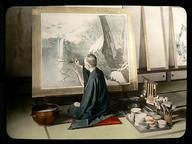Quiz Answer Key and Fun Facts
1. 'Jugendstil' is the German name for what modern art movement?
2. Which of these terms was applied to the works of artists like Robert Rauschenberg and John Chamberlain in the 1950s?
3. 'Jacobean Style' is a term applied to the furniture and architecture produced during the period of which English King's reign?
4. Which 'J' art term is used to describe the works of an artist during his/her formative years as a young person?
5. The upright sides of a window or door are called by what term?
6. The type of art created by Calder, Tinguely and others, in which pieces are placed in motion, is often referred to as what?
7. During the archaic Greek period, draped female figures appeared in great abundance. What were these figures called?
8. A German term, this describes a small collection of rare and delicate art pieces kept by princes during the Renaissance period...what is it?
9. Another ancient Greek term, this one refers to a container with a large mouth and body, a set of handles and an extended 'foot', used for the mixing of wine and water. What would we call such a container?
10. Which of these words could aptly be used to describe a 'kitsch' art piece?
Source: Author
thejazzkickazz
This quiz was reviewed by our editing team before going online.
Any errors found in FunTrivia content are routinely corrected through our feedback system.
